Britannia - Round sewing card (2)
From: Kreinik
Tokens and Trifles sewing cards are suitable for cross-stitch, ribbon embroidery and beading. Embroider in the perforated center and/or embellish the edge for a fast and easy project. Tokens and Trifles sewing cards have endless uses! Make needlebooks, ornaments, bookmarks, scrapbook labels, gift tags, place cards, or use your imagination for new projects. The ideal solution for various objects to quickly carve or embroid, to embellish your works with the complex yet very popular Canivet technique. The smooth premium paper finish with the non-perforated centers are suitable for watercolors, calligraphy, stamping and mounting of photos.
Each package contains one 20 count perforated sewing card, one blank sewing card, and a #28 tapestry needle.
Color: White
Size: 3 3/16" diameter
Read the post on this product in our blog
There are no reviews at the moment. Write your review
[ACCKREINIK-ATTBRIT #91565]Accessories
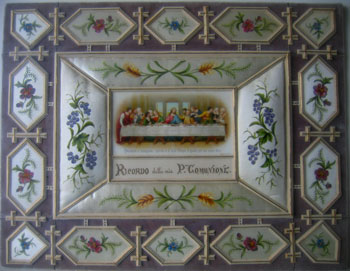 As expected – do you remember? I said: “I'm sure, you there loving beautiful things so much, you'll be amazed just as I am” – my article about the canivet has sparked off a good chat in our forum
As expected – do you remember? I said: “I'm sure, you there loving beautiful things so much, you'll be amazed just as I am” – my article about the canivet has sparked off a good chat in our forum  So, since – as you’ve probably already understood – I belong to the large group of people who, like Oscar Wilde, think that “the best way to get rid of a temptation is to yield to it”, I’ve yielded to the temptation of gathering some more information on this cool form of art! And, once again, I’m glad to share with you what I’ve discovered, always thanks to the help of one of our regular customers: Gabriella
So, since – as you’ve probably already understood – I belong to the large group of people who, like Oscar Wilde, think that “the best way to get rid of a temptation is to yield to it”, I’ve yielded to the temptation of gathering some more information on this cool form of art! And, once again, I’m glad to share with you what I’ve discovered, always thanks to the help of one of our regular customers: Gabriella  Let’s start from the picture you can see in this page, which I was kindly sent just by Gabriella. She confirmed that “this very ancient art was carried out by enclosed nuns, to realize holy and religious pictures” and Gabriella owns one of the pictures realized in this way: the one you can see in this picture that was made by a nun for Gabriella’s grandfather, on the day of his First Communion, at the end of the 19th century, as Gabriella explained to us!!! The painting is on silk and it frames a booklet – also hand-made – “all written with a pen-nib, in gothic letters, colored and in pure gold, completed with pictures painted on precious parchment”, explains our friend! It’s hard to find words suitable for commenting such a rarity, since in these cases, in my opinion, we’re talking of something going beyond one’s “personal taste”. I think, this you can like this object or not, but its art is indisputable and eve more, its historical value. If only this small wonder could talk, it would probably speak of hard-working hands, hours and hours of work in the light of the flickering flame of a candle, of homes and families where it has lived and of over a hundred years of events that its has witnessed: can you say it’s just a little thing???!!!??? I just can’t
Let’s start from the picture you can see in this page, which I was kindly sent just by Gabriella. She confirmed that “this very ancient art was carried out by enclosed nuns, to realize holy and religious pictures” and Gabriella owns one of the pictures realized in this way: the one you can see in this picture that was made by a nun for Gabriella’s grandfather, on the day of his First Communion, at the end of the 19th century, as Gabriella explained to us!!! The painting is on silk and it frames a booklet – also hand-made – “all written with a pen-nib, in gothic letters, colored and in pure gold, completed with pictures painted on precious parchment”, explains our friend! It’s hard to find words suitable for commenting such a rarity, since in these cases, in my opinion, we’re talking of something going beyond one’s “personal taste”. I think, this you can like this object or not, but its art is indisputable and eve more, its historical value. If only this small wonder could talk, it would probably speak of hard-working hands, hours and hours of work in the light of the flickering flame of a candle, of homes and families where it has lived and of over a hundred years of events that its has witnessed: can you say it’s just a little thing???!!!??? I just can’t  So, thanks a lot Gabriella, for sharing with us this treasure of yours and for giving me one more spur to go on looking for information about it
So, thanks a lot Gabriella, for sharing with us this treasure of yours and for giving me one more spur to go on looking for information about it  So, we now know that the canivet goes beyond stitching. And here’s what I’ve further discovered, sifting through the archives of an exhibition organized in 2004 by the Italian Museum of Capuchin Cultural Heritage. It seems that, already in the 16th century, some publishers experimented the technique of the “carving of prints”: the prints were carved on their edges, in order to use their carved part for the application on fabrics, inventing a better-value thing, also for commercial uses. Between the 16th and the 17th century, this carving art fell into disuse and blank sheets, both of paper and parchment, started to be used. Once again, the manufacturing of religious images was carried out mainly in feminine monasteries. Later, however, this art passed the boundaries and silence of convents and became a real fashion in the cultural salons and environments in many parts of continental Europe.
So, we now know that the canivet goes beyond stitching. And here’s what I’ve further discovered, sifting through the archives of an exhibition organized in 2004 by the Italian Museum of Capuchin Cultural Heritage. It seems that, already in the 16th century, some publishers experimented the technique of the “carving of prints”: the prints were carved on their edges, in order to use their carved part for the application on fabrics, inventing a better-value thing, also for commercial uses. Between the 16th and the 17th century, this carving art fell into disuse and blank sheets, both of paper and parchment, started to be used. Once again, the manufacturing of religious images was carried out mainly in feminine monasteries. Later, however, this art passed the boundaries and silence of convents and became a real fashion in the cultural salons and environments in many parts of continental Europe. 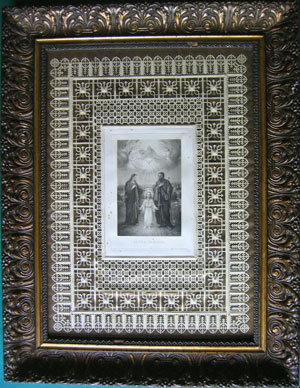 And, as it always happens with fashions, the canivet, too, started to follow the trends of its time: “this is why we can find precious carvings that are clearly referable to the decorative tastes of baroque and rococo time, featuring symbolic references in the choice of many elements that can be found both in small and large decorations, altars, tabernacles and shrines”, they explain at the Capuchin Cultural Heritage, adding: “sometimes, it can even be seen a precise will of the unknown carver to reproduce a complex frame, a sort of small shrine, as a reference to veneration in the canivet”. Unfortunately, we cannot reconstruct the canivet carving technique precisely. However, we suppose it probably started from a drawing, or from an embroidery work, that was then reported by punching or embedded on the base to be carved. In 1700, parchment was almost completely replaced by paper, that was softer and definitely cheaper and this is how the carving of folded sheets was born. “The iconographic choice, for holy images and canivet, is similar to that traditionally connected to carved, printed or stitched holy pictures, so it preserves a local character and it always refers to most traditional images”, goes on our reliable source, “ and a peculiarity is the size: smaller and smaller, showing a more and more refined carving quality, prevailing over the image itself, real subject of the holy representation, thus becoming a sort of miniature”. Until now, the names of the nuns who were skillful carvers of holy images on parchment and paper have remained unknown and this certainly adds a halo of further “mystic mystery” to these works of art, full of meanings that, we must admit, escape a little bit our modern and careless eyes, nevertheless so attracted. In any case, if you’re curious like me, here is a final hint to use as a starting point. History, in fact, gives us a name: that of Susanna Mayer from Augusta (1600-1674), the daughter of a painter and mother of another one, as well as one of the first and more skillful parchment carvers. As a proof of the fact that women are always in “the front line”, even – or better said “most of all” – when it comes on “beautiful things”
And, as it always happens with fashions, the canivet, too, started to follow the trends of its time: “this is why we can find precious carvings that are clearly referable to the decorative tastes of baroque and rococo time, featuring symbolic references in the choice of many elements that can be found both in small and large decorations, altars, tabernacles and shrines”, they explain at the Capuchin Cultural Heritage, adding: “sometimes, it can even be seen a precise will of the unknown carver to reproduce a complex frame, a sort of small shrine, as a reference to veneration in the canivet”. Unfortunately, we cannot reconstruct the canivet carving technique precisely. However, we suppose it probably started from a drawing, or from an embroidery work, that was then reported by punching or embedded on the base to be carved. In 1700, parchment was almost completely replaced by paper, that was softer and definitely cheaper and this is how the carving of folded sheets was born. “The iconographic choice, for holy images and canivet, is similar to that traditionally connected to carved, printed or stitched holy pictures, so it preserves a local character and it always refers to most traditional images”, goes on our reliable source, “ and a peculiarity is the size: smaller and smaller, showing a more and more refined carving quality, prevailing over the image itself, real subject of the holy representation, thus becoming a sort of miniature”. Until now, the names of the nuns who were skillful carvers of holy images on parchment and paper have remained unknown and this certainly adds a halo of further “mystic mystery” to these works of art, full of meanings that, we must admit, escape a little bit our modern and careless eyes, nevertheless so attracted. In any case, if you’re curious like me, here is a final hint to use as a starting point. History, in fact, gives us a name: that of Susanna Mayer from Augusta (1600-1674), the daughter of a painter and mother of another one, as well as one of the first and more skillful parchment carvers. As a proof of the fact that women are always in “the front line”, even – or better said “most of all” – when it comes on “beautiful things” 
Hugs ‘n XXX!
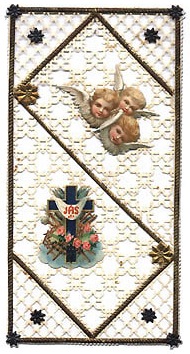 With this job (which is a privilege for me, since, more than a job, it's a passion to share), it happens sometimes that you catch up with something absolutely new...
With this job (which is a privilege for me, since, more than a job, it's a passion to share), it happens sometimes that you catch up with something absolutely new... Or, better said, something that's new for me, though it's not new at all... I know: it sounds a little tortuous, but keep reading and I'll explain everything
 Just a couple of days ago, I was pleased to get some emails from a very kind gentleman a customer of ours called Vincenzo, who was looking for some perforated paper for an ancient art - though, as already said, absolutely new for me - which he devotes himself to, with great passion and knowledge (as you can understand from the explanations he kindly gave me about it): the Canivet.
Just a couple of days ago, I was pleased to get some emails from a very kind gentleman a customer of ours called Vincenzo, who was looking for some perforated paper for an ancient art - though, as already said, absolutely new for me - which he devotes himself to, with great passion and knowledge (as you can understand from the explanations he kindly gave me about it): the Canivet.So, I said to myself: "how could I ever leave such a beautiful form of art closed in these emails?"... I thought it would have been a shame: just like when you receive a wonderful present and you keep it all for yourself, without showing it to anybody!!! I've never been able to - I konw, you'll probably think I'm a little "exhibitionist"... But is it so wrong, after all, when it comes on somoething so beautiful and rare? In this case, why not?!?!?!?!???? - so, here are some news about this Canivet, its origins and success, just as Vincenzo gave them to me. And, by the way, thanks Vincenzo for surprising me so much!
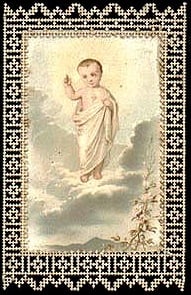 The Canivet is an art connected to small holy pictures and it was probably born in France, in the 13th century approx. With this craft, the holy pictures are realized in a sort of needlework on a light perforated paper with an as perforated edge, forming a lace. Just imagine the difficulty of depicting some figures of Saints in such small miniatures in this way
The Canivet is an art connected to small holy pictures and it was probably born in France, in the 13th century approx. With this craft, the holy pictures are realized in a sort of needlework on a light perforated paper with an as perforated edge, forming a lace. Just imagine the difficulty of depicting some figures of Saints in such small miniatures in this way  And, in fact, in Italian we have a way of saying that sounds more or less like this: "it takes the patience of a Carthusian monk" (in English, it should be the patience of Job!), just because craft works like this were left almost exclusively to the hands of monks and nuns in medieval monasteries and convents! They used to craft them as an expression of Christian faith and spiritual exercise, going beyond prayers. Today, what drives the fans of this art, such as Vincenzo, is maily the satisfaction they get from paper: an apparently poor material, but, on the contrary, an extraordinary and very versatile one, as Vincenzo, again, has confirmed: "I remember me as a child, always cutting and pasting some paper! It's a wonderful material, giving you extraordinary tactile and visual sensations".
And, in fact, in Italian we have a way of saying that sounds more or less like this: "it takes the patience of a Carthusian monk" (in English, it should be the patience of Job!), just because craft works like this were left almost exclusively to the hands of monks and nuns in medieval monasteries and convents! They used to craft them as an expression of Christian faith and spiritual exercise, going beyond prayers. Today, what drives the fans of this art, such as Vincenzo, is maily the satisfaction they get from paper: an apparently poor material, but, on the contrary, an extraordinary and very versatile one, as Vincenzo, again, has confirmed: "I remember me as a child, always cutting and pasting some paper! It's a wonderful material, giving you extraordinary tactile and visual sensations".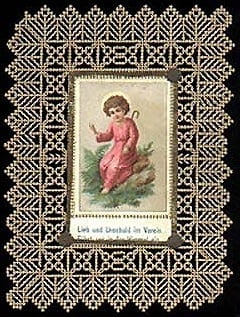 The present canivet paper is actually an evolution of the parchment used to make these holy pictures some centuries ago and, unbelievable, in an online auction I've just found out that one of this ancient holy pictures was sold for more than 800 euros, and it was probably a model realized on parchment, like those crafted by the nuns in the 18th century, with a small cutter called "canif", which they have taken their name "canivet" from. "They are very rare", again I was explained by Vincenzo. Today's canivet are base, as we have said a few lines above, on a special kind of perforated paper that was invented by the French publisher Bouasse-Lebel in the 19th century and, if you like the idea, just surf the Internet to see some examples of it: I'm sure, you there loving beautiful things so much, you'll be amazed just as I am
The present canivet paper is actually an evolution of the parchment used to make these holy pictures some centuries ago and, unbelievable, in an online auction I've just found out that one of this ancient holy pictures was sold for more than 800 euros, and it was probably a model realized on parchment, like those crafted by the nuns in the 18th century, with a small cutter called "canif", which they have taken their name "canivet" from. "They are very rare", again I was explained by Vincenzo. Today's canivet are base, as we have said a few lines above, on a special kind of perforated paper that was invented by the French publisher Bouasse-Lebel in the 19th century and, if you like the idea, just surf the Internet to see some examples of it: I'm sure, you there loving beautiful things so much, you'll be amazed just as I am 
Then, if you'd like to try this craft, we also have in stock the cartoncino perforato and two utili guide with many thrilling patterns to realize. In the meantime, just to get started, I'm very glad to publish some pictures of Vincenzo's works: thanks again Vincenzo and thanks to you all there, who will share your opinions with me!
See you soon!
Elena C.

VAT : IT01651310516 - R.E.A. 128424
Fax: +39-0575-033115 - Tel: +39-0575-421407
E-Mail: [email protected]

 English
English Français
Français Español
Español Italiano
Italiano


